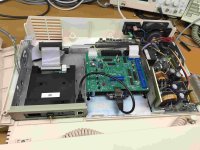Now that I'm loading up some other +IN images on the system I don't think +x perms are needed on the Install and remove scripts by default. My guess is the AT&T uucp installer just does a sh Install command to get things going so it's not required.I’ll see if I can modify the ETHERNET+IN I made previously from the 5 dd’d install disks so that it installs properly from /usr/spool/uucppublic - hopefully it’s just a matter of +x perms on the Install file, and potentially pad the +IN so it decompresses properly with the -B param used on cpio, which I don’t know if “install from electronic mail” uses -B or not.
I have not attempted to use the 5 dd images to install from floppy. Additionally those 5 dd’s are not on bitsavers. There are no IMD’s of the Ethernet disks available that I’m aware of but @shirsch mentioned having them. That would be great to get on bitsavers.
It was probably barfing when it couldn't load the ether.o file due to the aforementioned corruption. Fix that and the IN file is the way to go these days as you can just kermit it up and don't have to screw around with floppies.
Thanks for working on all this. I wonder who will be the next person to get Ethernet working. And on a side note, did the starlan card work with tcp/ip?

